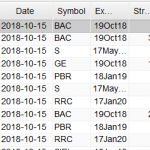
The US dollar and yields surged as the divergence meme, which had been increasingly doubted, returned with a vengeance. The 271k rise in nonfarm payrolls was most this year. The 2.5% year-over-year increase in average hourly earnings is the most in six years.
Begrudgingly, the market has come around to recognize the possibility, nay, the likelihood of a Fed rate hike next month. Despite the vagaries of the inventory cycle, the US economy continues to show what for many is a surprising resilience to the global headwinds. At the same time, the ECB still appears to be laying the groundwork for an expansion of its unorthodox monetary policy. The Bank of England has poured cold water on speculation that it would raise rates in the first part of 2016.
The Bank of Japan showed it is not in a hurry to step up its aggressive asset purchase program, but disappointment with the spring wage round could force a re-visit of the issue toward the beginning of the next fiscal year. In any event, it continues to purchase assets at an unprecedented pace.
The Dollar Index has rallied nearly 6% since the middle of October and is within 1% of its March high (~100.40). Recall that it rallied from around the middle of 2014 through March of this year. It moved lower from March through August but held the minimum retracement (38.2%) on the pullback. The subsequent price action looked to us to be corrective in nature and not the end of the bull run that so many investors and observers had heralded. Short-term technicals may be stretched. Initial support is seen near 98.00, but given the prospects for ECB easing a fortnight before the Fed hikes, dips in the Dollar Index will likely be bought as long dollar positions previously reduced are re-established.
The euro fell about 2.4% against the greenback last week. This is a little less than half of the (~5.2%) decline recorded since the eve of the ECB’s October 22 meeting. It is not just that the ECB is preparing to ease policy further (with a possible rate cut as well as adjustments to its asset purchase program), but it is also that the Fed will be hiking. It is when both sides of the equation are moving in opposite directions that has the potential for the greatest impact.














Leave A Comment